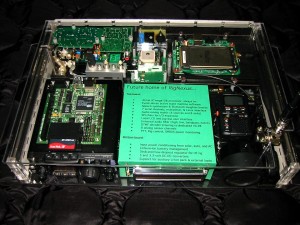I just received my invite to next year's Mountain Film Festival in Colorado, where I am due to present my video (yet to be edited) and give a presentation (yet to be written).
I was extremely flattered to see my name listed alongside the likes of Sir Ranulph Fiennes and Lynn Hill as 'Adventurers', and under 'Environment' I see that invitees include Richard Branson, Al Gore, Bill Clinton, Leonardo diCaprio, Robert Redford and the Dalai Lama.
Oooerrr, this is a MAJOR event. Better get editing...
|
|
You may have noticed that the Tracker's progress across the US has abruptly ceased shortly after lift-off. Rest assured - my co-driver Steve and I have not died, crashed, or been abducted by aliens.
How to explain? It became apparent early on that, errr, there was a mismatch of expectations and objectives around the road trip. The STARBOARD team has temporarily parted company, on the best of terms, and will be announcing exciting new technological-gizmological collaborations in due course.
I will be making alternative arrangements for Sedna to get shipped across from Miami to the West Coast. Her arrival in the US has in any case been delayed - I love Antigua, but it's not necessarily the place to get things done in a hurry. She was in the container and ready to go, but then failed to make it onto the ship. So this buys me a few extra days to sort out the next stage of her journey.
The best laid plans of mice, men and ocean rowers....
|
|
P.S. Don't worry if our Tracker on findu doesn't always stay up to date. It might possibly mean that we have suffered a breakdown/accident/technical failure, but is much more likely to mean that we are out of range of participating radio stations. Hopefully our absences will be short and our little canoe icon will soon start moving again.
(For the benefit of my US readers, the title comes from the British sitcom Dad's Army)
|
|

We were driving down Interstate 5, Steve at the wheel, when my cellphone rang. 'Roz, I can see you moving! You just passed an airport. And you're breaking the speed limit.'
It was Geoff, my friend in Leeds who has been helping me out with many things including enhancements to this website. He was all a-quiver to be able to see us moving across the map in close to real-time.
The Tracker sits in a large box between the two front seats, periodically emitting modem-type noises as it sends a packet of data skipping out across the States to a server in Florida. For those of an anorakky disposition, see below for a more comprehensive description of how it works (courtesy of Steve).
It's impressive that someone sitting in their home in Leeds can virtually watch a vehicle in Washington state zipping down the freeway, and can then speak to the passenger of that vehicle to let them know what town they just passed.
I just love technology when it works.
[Photo: Gizmology - the Tracker will form part of this complete mobile communications package, known as Shacktopus, currently under development at Nomadic Research Labs]
Now for the techie bit...
APRS is pretty cool stuff. In the truck, three components work together: a GPS receiver, a 2-meter ham radio, and a Packet TNC (Terminal Node Controller). The latter is a little computer whose job is to allow text to be transmitted and received over a radio that was designed for normal voice use... like an old-fashioned modem, but with a lot more smarts, it clumps text into "packets" that are then transmitted over the air as bursts of sound. In the case of the tracker, these take a special form that includes the current latitude, longitude, and speed.
When one of these is received by another amateur radio packet station that has been dedicated to APRS use, it is immediately forwarded on... and within a few seconds the location beacon has covered hundreds of miles. Some of these stations include an Internet gateway, and, with luck, it will catch the packet and re-send it to a computer down in the Florida Keys. Steve Dimse K4HG, a friend of Steve's, is the fellow who developed that, and it disassembles the packet and inserts the location and call (in this case, N4RVE) into a database.
When you click the link from Roz's blog, the findu server displays the appropriate region from the Google Maps server, then places an icon at the most recently received location. In our case, this is a little canoe, and if all goes well it can be updated as often as once a minute.
When Geoff called us yesterday, we had a chuckle at the number of computers (including tiny embedded ones) that were involved in letting him see our location. Steve estimated that the data had passed through somewhere around 50 separate processors to bring you that little canoe zipping down I-5...
|
|